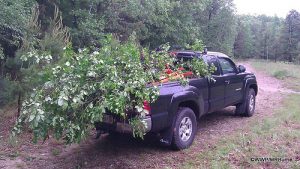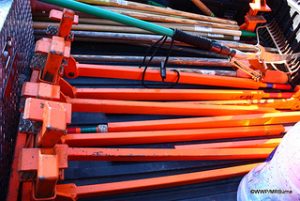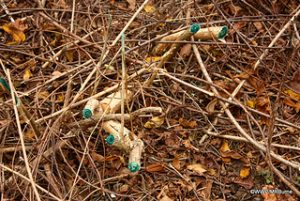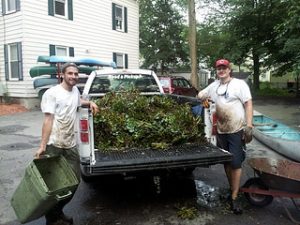Invasive Plant Removal Methods
Removing invasive species may include manual, mechanical, or chemical methods or a combination thereof. Manual and mechanical methods involve physically removing plants from the environment through cutting or pulling. Chemical methods use herbicides to kill plants and inhibit regrowth. The technique and chemical used varies with the species.
Several techniques may be effective in controlling a single species. Regardless of the method selected, it is very important to minimize the impact on non-target species and the environment. Additionally, special consideration should be paid to their disposal.
Manual methods

-
- Pull
- Hand pull- anything small enough grasp and shallow-rooted
- Too big to pull by hand? Dig roots out with Weed Wrench, shovel or any similar tool
- Smother
- Cover low growing plants with thick UV-stabilized plastic or cardboard to prevent photosynthesis
- Cut small woody plant and cover stump with plastic and secure with zip tie
- Girdle Trees
- Cut through the bark and growing layer (cambium) all around the trunk, about 6″ above the ground
- Most effective in spring or late summer
- Remove suckers or new growth
- Cut through the bark and growing layer (cambium) all around the trunk, about 6″ above the ground
 Preventative Actions
Preventative Actions
- Save trees by cutting vines at base of tree and should height. Leave vine in tree to desiccate
- Prevent seeds by removing flowers
- Remove seeds/fruit and place in a heavy plastic bag
- Pull
Mechanical methods
-
- Mow or cut back the plants at least three times a season to starve the roots
- For trees, cut down, grind out the stump, and remove suckers or new growth.
Chemical methods
General Herbicide Categories
-
 Non-systemic herbicide will kill the part of the plan it touches, but will usually not kill well-established plants
Non-systemic herbicide will kill the part of the plan it touches, but will usually not kill well-established plants- Systemic herbicide absorb into the plant foliage and/or stem, then move and accumulate to toxic levels in the growing points or roots
Both types of herbicide can be applied selectively with minimal impact to non-target species.
Herbicide Application Types
-
- Cut and paint- cut stem and paint herbicide with dye onto stump
- Foliar spray- primarily best when invasives are densely packed
- Basal bark- coat the base of a woody invasive
- Injection- inject herbicide into hollow stem (knotweed)
- Hack and squirt- cut a slice into the bark of a tree and squirt herbicide directly into the cut
Herbicides should be used when the infestation cannot be controlled through other methods alone.
Caution: Applying herbicides to control invasive plants on property you do not personally own requires a pesticide applicator’s license issued by the state. A pesticide applicator’s license is required to use herbicides on public and private conservation lands.
Caution: Any activities in wetlands (from removing invasives by hand or by applying herbicides) may require a special permit under the Wetlands Protection Act and/or your local bylaws. Be sure to contact your local Conservation Commission before you act.
Notice: Mention Of Pesticide Products On This Web Site Does Not Constitute Endorsement Of Any Material.
Controlled burning
Controlled burning may require a permit – check with your local fire department and Conservation Committee before you act. Burns should occur in the spring, under control of professionals, and repeat over several years. Some invasive species will be negatively affected while others will respond with enthusiasm so please do the appropriate research.
Invasive plant disposal methods
Proper disposal of removed invasive plant material is critical to the control process. Leftover plant material can cause new infestations. In general, remove flowers, seeds, and fruits before they ripen, and place them in heavy black garbage bags 4 mil or thicker to prevent re-sprouting. On some plants, flowers can mature and set seed even after the plant has been pulled.
Some disposal methods include:

- Burn
- Make a brush pile and burn the material following local safety regulations and restrictions, including obtaining a burn permit,
- If allowed, take it to your town’s landfill burn pile
- Invasive Compost Pile
- Pile invasives to allow them to desiccate
- Monitor for resprouts
- Do not use the resulting compost in your garden
- Dry
- Place woody debris on your driveway or any asphalt surface and let it dry out for a month.
- Place herbaceous material in a doubled-up black trash bag and let dry in the sun for one month.
- The material should then be non-viable and can be disposed of in the trash (confirm with municipality)
- Chip and Compost
- Prior to flowering chip and use mulch on site. Do Not compost if chipped during or after flowering
Note that the following plants can sprout vigorously from plant fragments:
- Oriental bittersweet
- Multiflora rose
- Phragmites
- Japanese knotweed
These plants should ideally be burned or dried prior to disposal.